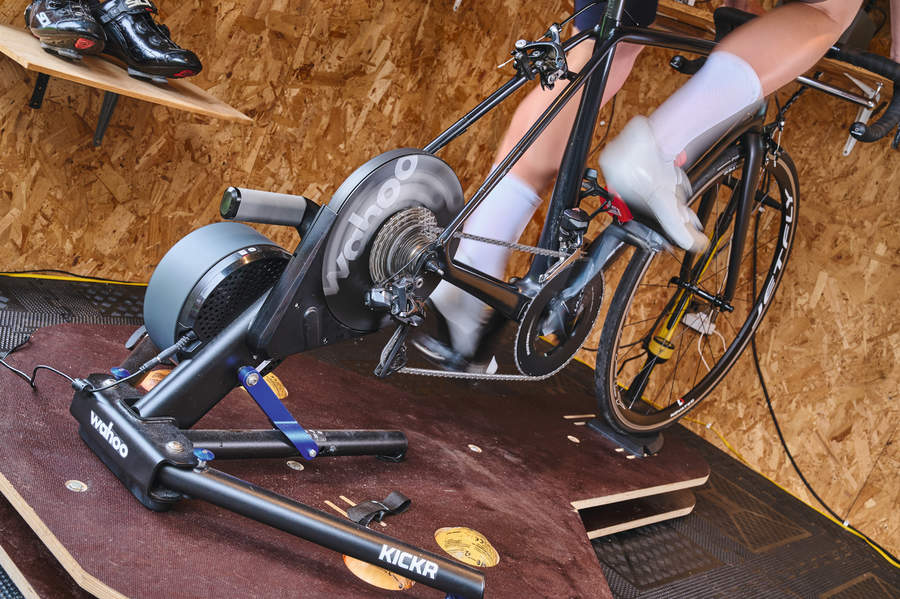Tech Question: Do ‘moving’ indoor trainers result in less turbo fatigue?
Can moving turbos stave off fatigue and help us get more out of our winter training? Jack Elton-Walters speaks to the experts to try and find out

Anyone who spends time on even one of the best turbo trainers will know the feeling of numb glutes, a stiff lower back or other aches and pains that aren’t there after a bike ride out on the road. Riding an unmoving bike, clamped into a static machine sees us use our muscles in a subtly different way. And as we do more of it, turbo injuries are becoming more widespread.
This has been witnessed by former British Cycling physiotherapist Phil Burt, now owner of a cycle training and bike fit company. “In the pandemic, indoor cycling just went bonkers,” Burt recalled. “People who had been cycling for 20 plus years were all of a sudden having knee issues and saddle sores. It’s because of how different the loading profile of indoor cycling is compared to outdoor cycling.”
This lack of movement is what ‘moving’ trainers aim to address – from Wahoo’s Kickr Move, with its fore-aft movement, to Lifeline’s Rocker Plate that will move with the rider’s shifting weight, all the way to products with a huge range of motion such as the Gymrail Momentum X1 Smart Trainer Movement System. The objective is often referred to as ‘fatigue reduction’, but this is something Burt doesn’t feel is entirely accurate.
“I don’t think a moving turbo will prevent fatigue, what it probably prevents is overloading of certain tissues which I’d imagine some people would call fatigue – I would call it overloading certain areas more than they normally would be, so a moving trainer represents an opportunity to avoid that.”
Tyler Harris, Cycling Product Manager at Wahoo Fitness, agrees there is over-emphasis on fatigue. “I wouldn't necessarily say it [a moving turbo] reduces fatigue, but rather adds comfort which could give the rider the perception of less fatigue.”
Someone who knows all about time on the turbo is Teppo Laurio, who describes himself as a modest Finn, Cycling eSports pro/elite rider, Olympic eSports series athlete, cyclist. He regularly does six hour indoor cycling sessions with a Gymrail Momentum X1 rocker system under a Wahoo Kickr and says he wouldn’t go back to static trainers.
“I’ve used it for almost two years. I have spent hundreds of hours on it and I don’t really like to race without it anymore. It’s beneficial to my riding. I like to do really long training hours; like six hour rides on a trainer, so the movement helps with the lower back pain that I get with stationary trainers.”
The latest race content, interviews, features, reviews and expert buying guides, direct to your inbox!
Laurio has found that using a moving trainer has boosted his indoor racing performance by better replicating the ability he has out on the road. “With the Gymrail I’ve got closer to my outdoor sprint power; I gained almost 100 watts [compared to a static trainer]. So yeah, there is something in it,” he chuckles.

Recreating your outdoor sprint numbers indoors can be tough with no movement
Laurio’s experience matches Burt’s findings back in his BC days. “What I can tell you is that when I was at British Cycling and we’d do lab tests with riders, the lab test never ever correlates to the real life situation in terms of power output,” Burt says. “They always get more power out on the track, their peak power will always be more than on a static rig in the lab. They can manipulate the bike underneath them to optimise the position for producing the power. So we do know that moving bikes might better replicate the real world situation.”
Wahoo has studied the effects of movement on riders using its turbo trainers, as Harris explains: “Our studies have shown an increase in rider comfort as movement in the trainer causes the rider’s position to shift around versus sitting still on a static trainer. This movement certainly aids in less saddle soreness and comfort.”
Getting riders to move around and stop pressure build up during turbo sessions – “literally just stand up for two seconds every 10 minutes” – is something Burt is emphatic about, but adds a note that might not suit those trying to sell more turbo trainers. “I think the cost-benefit relationship is something to consider. Do you need to pay for a whole new trainer or do you put a stopwatch on your handlebar that tells you to get out of the saddle every 10 minutes?”
We say

Ardent indoor racers may benefit from this tech
For hardcore indoor riders and racers, there is growing evidence of the benefits of a moving trainer, but for injury free riders simply complementing their outdoor riding with sporadic turbo sessions, the cost-benefit of investing in a whole new set up might not be worthwhile.
Jack Elton-Walters hails from the Isle of Wight, and would be quick to tell anyone that it's his favourite place to ride. He has covered a varied range of topics for Cycling Weekly, producing articles focusing on tech, professional racing and cycling culture. He moved on to work for Cyclist Magazine in 2017 where he stayed for four years until going freelance. He now returns to Cycling Weekly from time-to-time to cover racing, review cycling gear and write longer features for print and online.